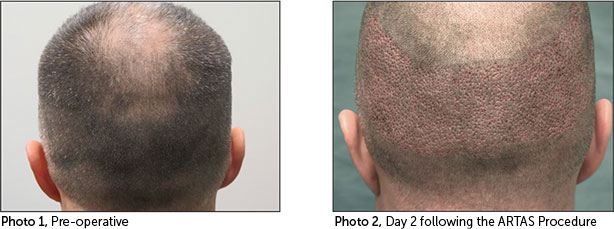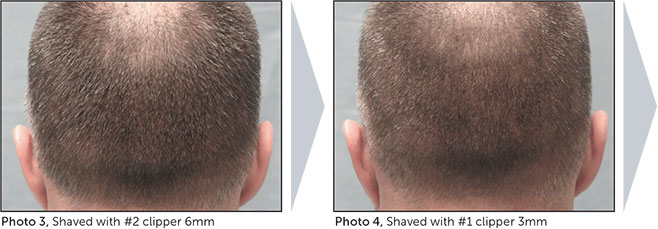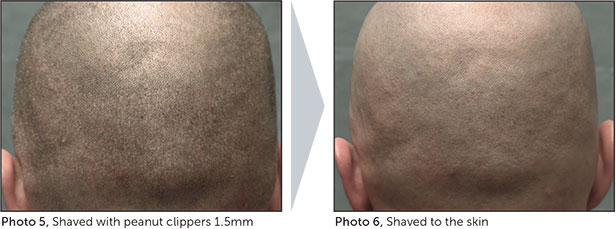Robert M. Bernstein, M.D.
Restoration Robotics White Paper. September 2014.
Introduction
The ARTAS® Robotic System facilitates hair restoration surgery through minimally invasive follicular unit harvesting. Patient benefits include; no linear scar, less pain and minimal post-op discomfort. By preserving the natural appearance of the donor area, it allows patients to wear shorter hairstyles without detecting the wound scars. This is an important goal for many persons seeking surgical hair restoration. Factors that influence scarring in the donor area include: dissection punch size, density of harvest sites, distribution of the harvest sites, total number of sites, and the ‘blending in’ of harvest zones with un-harvested areas. The ARTAS® Robotic System provides a unique, comprehensive suite of tools that physicians can use to minimize donor area scarring and offer the patient greater styling options post-surgery.
Case Study
The patient is a 46-year old white Caucasian male with Norwood Stage 5A Male Pattern Baldness. He has dark brown, straight hair of medium-fine caliber and a donor density of 2.1hairs/mm2. His skin color is Fitzpatrick Type III. (Photo 1)
The patient underwent harvesting with the ARTAS Robotic System using features available with the new software version 7.0 (2014). The following tools helped to preserve the natural appearance of the donor area.
Features include:
- 19g Needle for Dissection: This leaves a smaller surface wound (0.9mm) and minimizes scarring. Smaller sites heal more rapidly.
- “No F1s” Software Algorithm: A new intelligent software algorithm that preferentially harvests follicular units containing multiple hairs (F2 or more). This maximizes the amount of hair follicles which are harvested per graft.
- Minimum Distance Between Harvest Sites: An intelligent algorithm that controls the minimum distance between harvests sites. The minimum distance was increased from 1.7mm to 2.0mm and accommodates decreasing hair density as the dissection progressed from the occipital scalp to the sides of the head. It also enables a blending or “feathering” effect between harvested and non-harvested zones making the harvesting less noticeable.
- Intuitive Controls: This gives the user the ability to make adjustments in real-time, allowing the physician to adapt to changes in the characteristics specific to each patient’s donor area.
The patient had 2,540 harvests to obtain a total of 2,768 grafts for implantation (Photo 2). The average number of hairs per follicular unit was 2.6 and the harvest yield was 95.2% prior to splitting the grafts to obtain more 1-hair follicular units. Post-operative care of the donor area consisted of gentle washing and applying ointment (Bacitracin®, AQUAPHOR®) for 7 days to keep the donor area moist and prevent it from drying out.
During the third post-operative month, the patient returned to the clinic to undergo an examination of his donor area and an evaluation of the visibility of wound scars. His donor area hair was gradually shortened to different lengths in order to see how short he could wear his hair before scarring from the harvest sites was detectable. The hair lengths were:
- #2 Clippers, approximately 6 mm (Photo 3)
- #1 Clippers, approximately 2.5 mm (Photo 4)
- Close cut using the Wahl Peanut Clippers (Photo 5)
- Shaved down to skin (Photo 6)
Even when the hair was shaved down to skin, the detectability of the wound scars was extremely low. The harvest zones blended, or transitioned, into the un-harvested areas so that there were no detectible changes in hair density as one progressed from one region of the scalp to another.
Immediately Post-procedure

Three Months Post-procedure


Photos courtesy of Bernstein Medical – Center for Hair Restoration
Conclusion
The ARTAS® Robotic System provides a comprehensive suite of tools to minimize the detectability of wound scars post-surgery and maintain the natural appearance of the donor area.
The ARTAS® System from Restoration Robotics is indicated for harvesting hair follicles from the scalp in men diagnosed with androgenic alopecia (male pattern hair loss) who have black or brown straight hair. The ARTAS System is intended to assist physicians in identifying and extracting hair follicular units from the scalp during hair transplantation.
© 2014 Restoration Robotics, Inc. All Rights Reserved. Restoration Robotics, ARTAS and the stylized logos are among the trademarks and/or registered trademarks of Restoration Robotics Inc.






